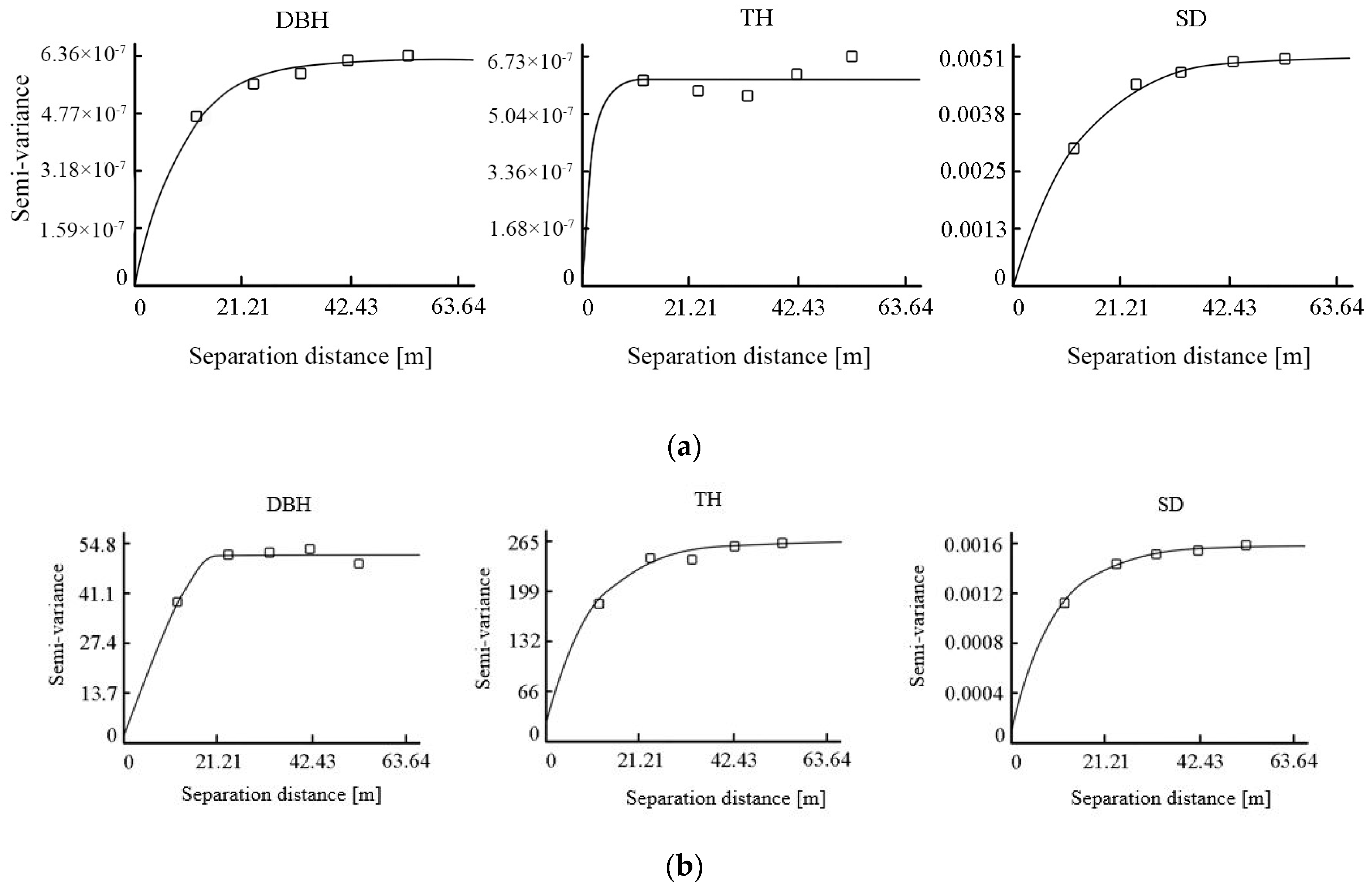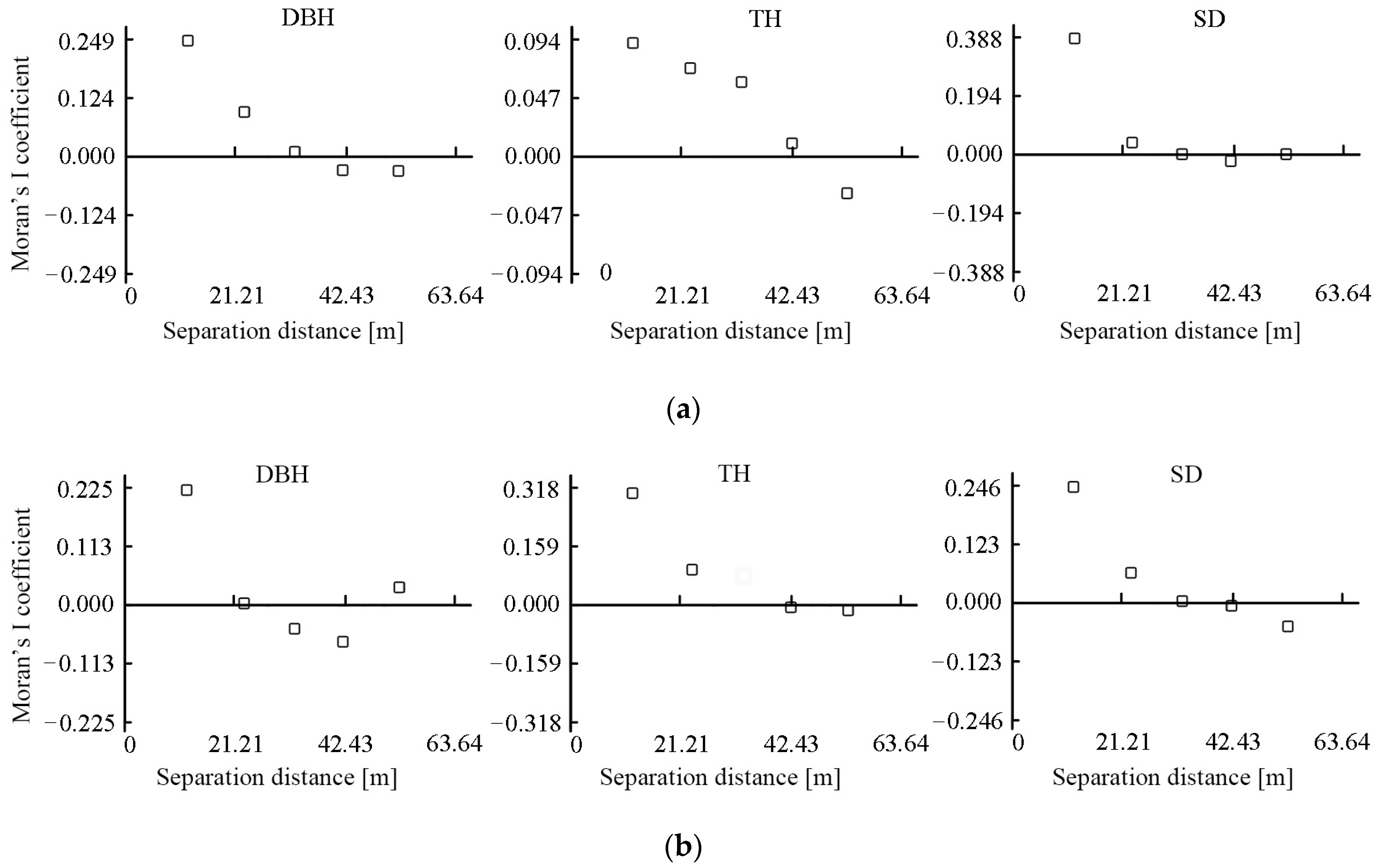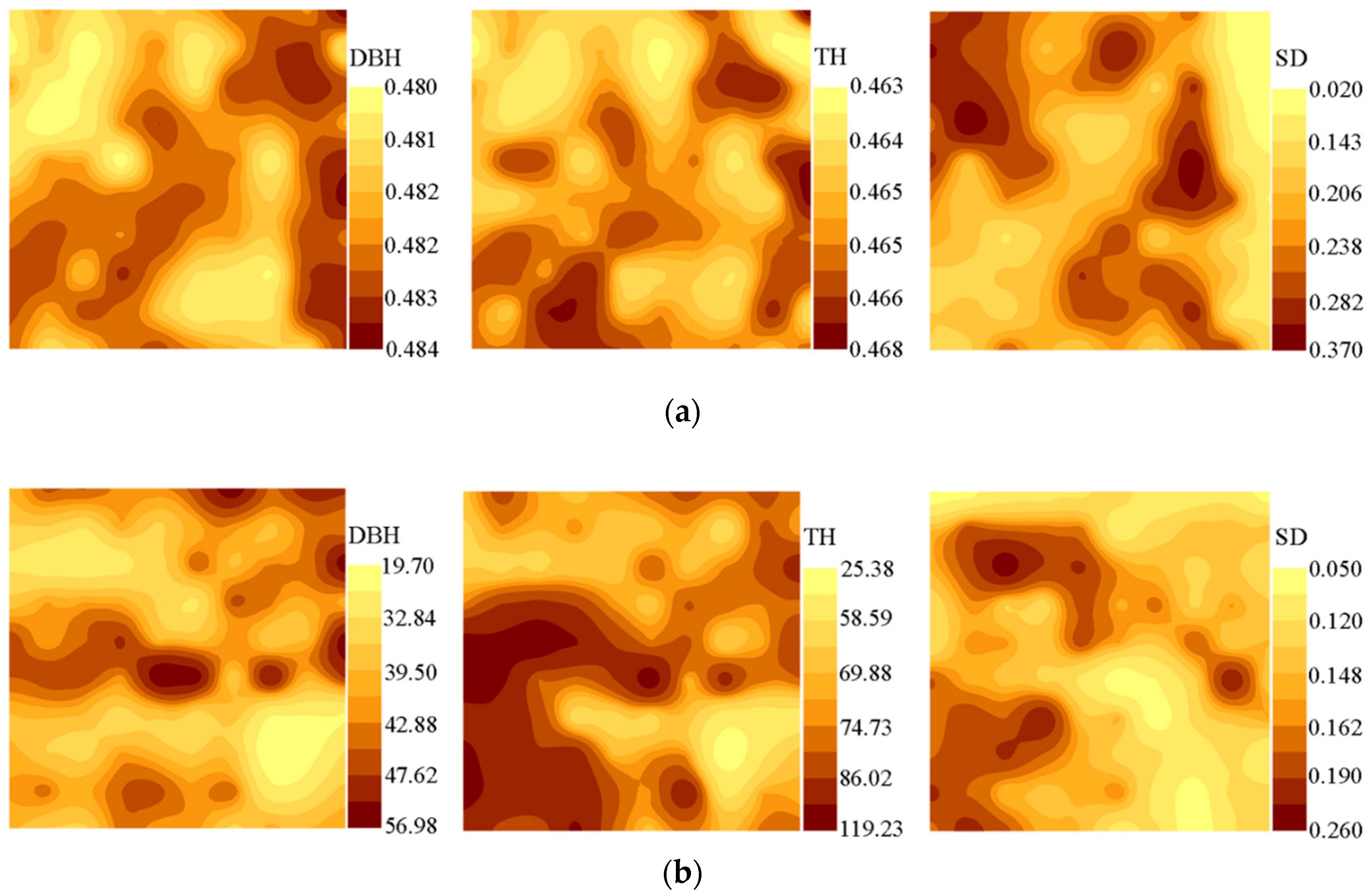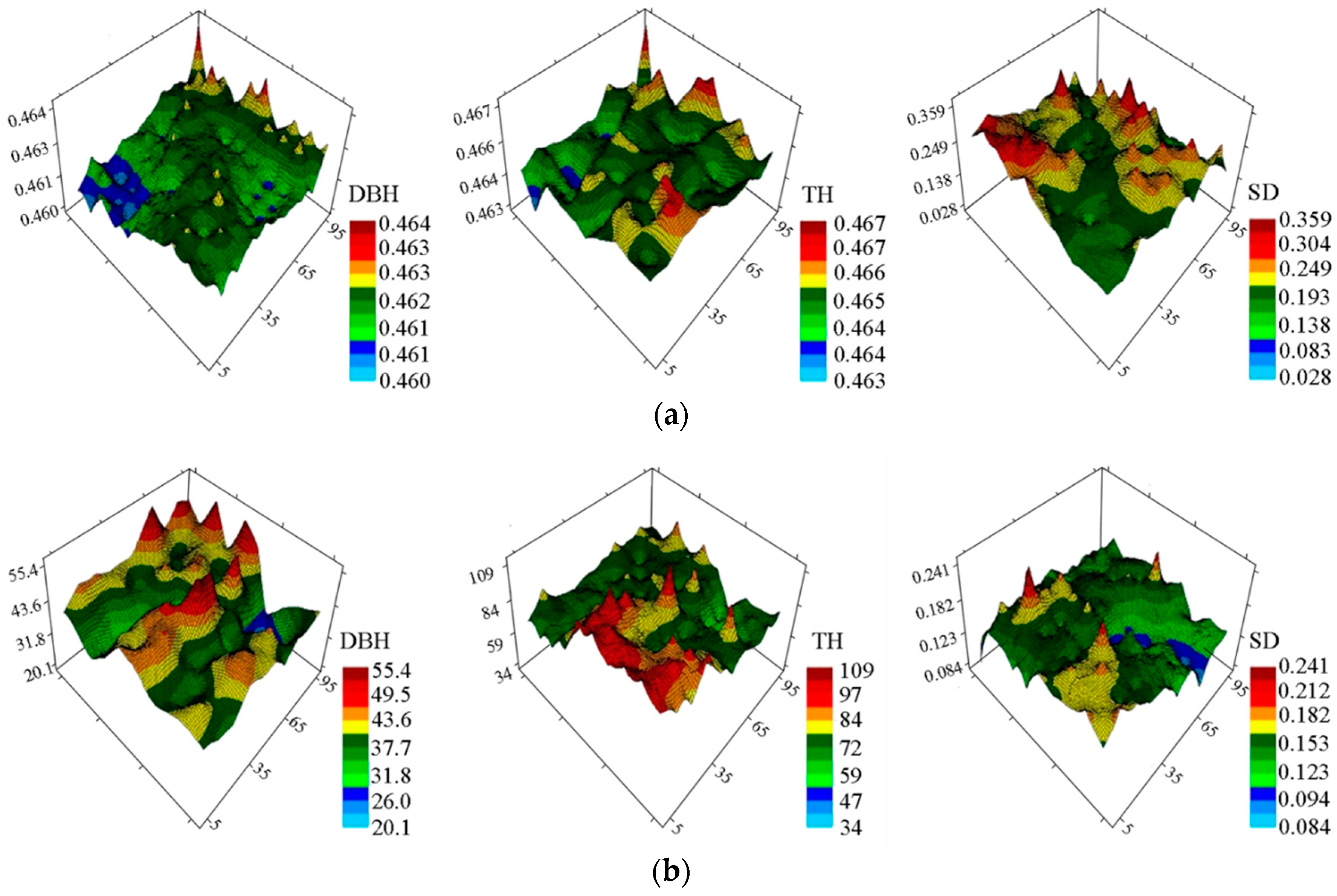Spatial Distribution Pattern of Response of Quercus Variabilis Plantation to Forest Restoration Thinning in a Semi-Arid Area in China
Abstract
1. Introduction
2. Materials and Methods
2.1. Study Area and Experimental Design
2.2. Spatial Autocorrelation and Distribution Analysis
2.2.1. Semi-Variance Function
2.2.2. Moran’s Index
2.2.3. Fractal Dimension
2.2.4. Kriging Interpolation Method
2.3. Data Processing
3. Results
3.1. Effect of Forest Thinning on the DBH, Tree Height, and Stand Density of Quercus Variabilis Plantation
3.2. Influence of Forest Thinning on the Spatial Distribution Patterns of DBH, Tree Height, and Stand Density of Quercus Variabilis Plantation
3.2.1. The Semi-Variance Function Analysis of DBH, Tree Height, and Stand Density of Quercus Variabilis Plantation
3.2.2. Fractal Dimension of DBH, Tree Height, and Stand Density of Quercus Variabilis Plantation
3.2.3. Spatial Autocorrelation of DBH, Tree Height, and Stand Density of Quercus Variabilis Plantation
3.2.4. Spatial Distribution Pattern of DBH, Tree Height, and Stand Density of Quercus Variabilis Plantation
4. Discussion
4.1. The Effect of Thinning on the Non-Spatial Structure of Quercus Variabilis Plantation
4.2. The Effect of Thinning on the Spatial Heterogeneity of Quercus Variabilis Plantation
4.3. The Suggestion of Forest Restoration Thinning in the Semi-Arid Area
5. Conclusions
Author Contributions
Funding
Data Availability Statement
Conflicts of Interest
References
- Yohannes, Y. Effect of thinning on biophysical soil properties of Cupressus lusitanica stand in Munessa forest, Ethiopia. Ethiop. J. Sci. Technol. 2019, 12, 233–248. [Google Scholar] [CrossRef]
- Makinen, H.; Isomaki, A. Thinning intensity and growth of Scots pine stands in Finland. For. Ecol. Manag. 2004, 201, 311–325. [Google Scholar] [CrossRef]
- Sohn, J.A.; Saha, S.; Bauhus, J. Potential of forest thinning to mitigate drought stress: A meta-analysis. For. Ecol. Manag. 2016, 380, 261–273. [Google Scholar] [CrossRef]
- Curtis, R.O.; Marshall, D.D.; Bell, J.F. LOGS: A pioneering example of silvicultural research in coast Douglas-fir. J. For. 1997, 95, 19–25. [Google Scholar] [CrossRef]
- Bauhus, J.; Puettmann, K.; Messier, C. Silviculture for old-growth attributes. For. Ecol. Manag. 2009, 258, 525–537. [Google Scholar] [CrossRef]
- Di, S.J. River red gum (Eucalyptus camaldulensis): A review of ecosystem processes, seedling regeneration and silvicultural practice. Aust. For. 2002, 65, 14–22. [Google Scholar]
- Dagley, C.M.; Berrill, J.P.; Leonard, L.P.; Kim, Y.G. Restoration thinning enhances growth and diversity in mixed redwood/Douglas-fir stands in northern California, USA. Restor. Ecol. 2018, 26, 1170–1179. [Google Scholar] [CrossRef]
- Plummer, J.F.; Keyes, C.R.; Varner, J.M. Early-Stage thinning for the restoration of young redwood—Douglas-Fir forests in northern coastal California, USA. Restor. Ecol. 2012, 2012, 725827. [Google Scholar] [CrossRef]
- Hood, S.M.; Cluck, D.R.; Jones, B.E.; Pinnell, S. Radial and stand-level thinning treatments: 15-year growth response of legacy ponderosa and Jeffrey pine trees. Restor. Ecol. 2018, 26, 813–819. [Google Scholar] [CrossRef]
- Puettmann, K.; Ares, A.; Burton, J.; Dodson, E. Forest restoration using variable density thinning: Lessons from Douglas-fir stands in Western Oregon. Forests 2016, 7, 310. [Google Scholar] [CrossRef]
- O’Hara, K.L. Stand growth efficiency in a Douglas-fir thinning trial. Forestry 1989, 62, 409–418. [Google Scholar] [CrossRef]
- Lagergren, F.; Lankreijer, H.; Kucera, J.; Cienciala, E.; Molder, M.; Lindroth, A. Thinning effects on pine-spruce forest transpiration in central Sweden. For. Ecol. Manag. 2008, 255, 2312–2323. [Google Scholar] [CrossRef]
- Kuehne, C.; Weiskittel, A.R.; Wagner, R.G.; Roth, B.E. Development and evaluation of individual tree-and stand-level approaches for predicting spruce-fir response to commercial thinning in Maine, USA. For. Ecol. Manag. 2016, 376, 84–95. [Google Scholar] [CrossRef]
- Harrington, C.A.; Reukema, D.L. Initial shock and long-term stand development following thinning in a Douglas-fir plantation. For. Sci. 1983, 29, 33–46. [Google Scholar]
- Sharma, M.; Smith, M.; Burkhart, H.E.; Amateis, R.L. Modeling the impact of thinning on height development of dominant and codominant loblolly pine trees. Ann. For. Sci. 2006, 63, 349–354. [Google Scholar] [CrossRef]
- Makinen, H.; Isomaki, A. Thinning intensity and growth of Norway spruce stands in Finland. Forestry 2004, 77, 349–364. [Google Scholar] [CrossRef]
- Moulinier, J.; Brais, S.; Harvey, B.D.; Koubaa, A. Response of boreal jack pine (Pinus banksiana Lamb.) stands to a gradient of commercial thinning intensities, with and without N fertilization. Forests 2015, 6, 2678–2702. [Google Scholar] [CrossRef]
- Connell, M.J.; Raison, R.J.; Jenkins, P. Effects of thinning and coppice control on stand productivity and structure in a silvertop ash (Eucalyptus sieberi L. johnson) forest. Aust. For. 2003, 67, 30–38. [Google Scholar] [CrossRef]
- Primicia, I.; Artázcoz, R.; Imbert, J.B.; Puertas, F.; Traver, M.C.; Castillo, F.J. Influence of thinning intensity and canopy type on scots pine stand and growth dynamics in a mixed managed forest. For. Syst. 2016, 25, e057. [Google Scholar] [CrossRef]
- Bose, A.K.; Weiskittel, A.; Kuehne, C.; Wagner, R.G.; Turnblom, E.; Burkhart, H.E. Does commercial thinning improve stand-level growth of the three most commercially important softwood forest types in North America? For. Ecol. Manag. 2018, 409, 683–693. [Google Scholar] [CrossRef]
- Zasada, M.; Bronisz, K.; Bijak, S.; Dudek, A.; Bruchwald, A.; Wojtan, R.; Tomusiak, R.; Bronisz, A.; Wróblewski, L.; Michalak, K. Effect of the cutting age and thinning intensity on biomass and carbon sequestration—The Gubin forest district case study. Folia For. Pol. 2009, 51, 18–24. [Google Scholar]
- Li, X.; Li, Y.; Zhang, J.; Peng, S.; Chen, Y.; Cao, Y. The effects of forest thinning on understory diversity in china: A meta-analysis. Land Degrad. Dev. 2020, 31, 1225–1240. [Google Scholar] [CrossRef]
- Franklin, J.F.; Spies, T.A.; Pelt, R.V.; Carey, A.B.; Thornburgh, D.A.; Berg, D.R.; Lindenmayer, D.B.; Harmon, M.E.; Keeton, W.S.; Shaw, D.V. Disturbance and structural development of natural forest ecosystems with silvicultural implications, using Douglas-fir as an example. For. Ecol. Manag. 2002, 155, 399–423. [Google Scholar] [CrossRef]
- Sánchez, M.A.J.; Moore, M.M.; Bakker, J.D.; Parysow, P.F. 108 years of change in spatial pattern following selective harvest of a ponderosa pine stand in northern Arizona, USA. J. Veg. Sci. 2009, 20, 79–90. [Google Scholar] [CrossRef]
- Das, A.; Battles, J.; Stephenson, N.L.; Mantgem, P.J.V. The contribution of competition to tree mortality in old-growth coniferous forests. For. Ecol. Manag. 2011, 261, 1203–1213. [Google Scholar] [CrossRef]
- North, M.; Stine, P.; O’Hara, K.; Zielinski, W.; Stephens, S. An Ecosystem Management Strategy for Sierran Mixed-Conifer Forests, 2nd ed.; General Technical Report, PSW-GTR-220; Forest Service: Missoula, MT, USA, 2009. [Google Scholar]
- Larson, A.J.; Churchill, D. Tree spatial patterns in fire-frequent forests of western North America, including mechanisms of pattern formation and implications for designing fuel reduction and restoration treatments. For. Ecol. Manag. 2012, 267, 74–92. [Google Scholar] [CrossRef]
- Shaver, G.R. Spatial heterogeneity: Past, present, and future. In Ecosystem Function in Heterogeneous Landscapes; Springer: New York, NY, USA, 2005; pp. 443–449. [Google Scholar]
- Zhu, X.; He, Z.B.; Du, J.; Chen, L.F.; Lin, P.F.; Tian, Q.Y. Spatial heterogeneity of throughfall and its contributions to the variability in near-surface soil water-content in semiarid mountains of China. For. Ecol. Manag. 2021, 488, 119008. [Google Scholar] [CrossRef]
- Dutilleul, P.; Legendrem, P. Spatial heterogeneity against heteroscedasticity: An ecological paradigm versus a statistical concept. Oikos 1993, 66, 152–171. [Google Scholar] [CrossRef]
- Tscharntke, T.; Steffan-Dewenter, I.; Kruess, A.; Thies, C. Characteristics of insect populations on habitat fragments: A mini review. Ecol. Res. 2002, 17, 229–239. [Google Scholar] [CrossRef]
- Leyequien, E.; Verrelst, J.; Slot, M.; Schaepman-Strub, G.; Heitkönig, I.M.A.; Skidmore, A. Capturing the fugitive: Applying remote sensing to terrestrial animal distribution and diversity. Int. J. Appl. Earth Obs. Geoinf. 2007, 9, 1–20. [Google Scholar] [CrossRef]
- Tilman, D.; Kareiva, P. Spatial Ecology: The Role of Space in Population Dynamics and Interspecific Interactions; Princeton University Press: Princeton, NJ, USA, 1997. [Google Scholar]
- Rosindell, J.; Wong, Y.; Etienne, R.S. A coalescence approach to spatial neutral ecology. Ecol. Inform. 2008, 3, 259–271. [Google Scholar] [CrossRef]
- Franklin, J.F.; Mitchell, R.J.; Palik, B.J. Natural Disturbance and Stand Development Principles for Ecological Forestry; General Technical. Report. NRS-19; USDA Forest Service, Northern Research Station: Delaware, PA, USA, 2007. [Google Scholar]
- Nyland, R.D. Silviculture: Concepts and Applications; McGraw-Hill: New York, NY, USA, 2002. [Google Scholar]
- Churchill, D.J.; Larson, A.J.; Dahlgreen, M.C.; Franklin, J.F.; Hessburg, P.F.; Lutz, J.A. Restoring forest resilience: From reference spatial patterns to silvicultural prescriptions and monitoring. For. Ecol. Manag. 2013, 291, 442–457. [Google Scholar] [CrossRef]
- Peck, J.L.E.; Zenner, E.K.; Brang, P.; Zingg, A. Tree size distribution and abundance explain structural complexity differentially within stands of even-aged and uneven-aged structure types. Eur. J. For. Res. 2014, 133, 335–346. [Google Scholar] [CrossRef]
- Choe, C.H.; Kim, J.H.; Xu, C.Y.; Choe, J.S.; Man, H.S.; Jo, S.M. Effect of soil nutrient spatial heterogeneity by cutting disturbance on understory plant diversity in broadleaved-Korean pine forest in Changbai mountain, China. Eur. J. For. Res. 2021, 140, 603–613. [Google Scholar] [CrossRef]
- Kuehne, C.; Weiskittel, A.R.; Fraver, S.; Puettmann, K.J. Effects of thinning-induced changes in structural heterogeneity on growth, ingrowth, and mortality in secondary coastal Douglas-fir forests. Can. J. For. Res. 2015, 45, 1448–1461. [Google Scholar] [CrossRef]
- Larson, A.J.; Stover, K.C.; Keyes, C.R. Effects of restoration thinning on spatial heterogeneity in mixed-conifer forest. Can. J. For. Res. 2014, 42, 1505–1517. [Google Scholar] [CrossRef]
- Tian, F.; Yan, Y.B. A sift feature matching algorithm based on semi-variance function. Adv. Mater. Res. 2013, 647, 896–900. [Google Scholar] [CrossRef]
- Goovaerts, P. Geostatistics for Natural Resources Evaluation (Applied Geostatistics); Oxford University Press: Oxford, UK, 1997. [Google Scholar]
- Montero, J.M.; Fernández-Avilés, G.; Mateu, J. Spatial and Spatio-Temporal Geostatistical Modeling and Kriging. John Wiley and Sons: New York, NY, USA, 2015. [Google Scholar]
- Gräler, B.; Pebesma, E.; Heuvelink, G. Spatio-temporal interpolation using gstat. R J. 2016, 8, 204–218. [Google Scholar] [CrossRef]
- Pham, Q.H.; Gagnon, M.; Antoni, J.; Tahan, A.; Monette, C. Prediction of hydroelectric turbine runner strain signal via cyclostationary decomposition and kriging interpolation. Renew. Energy 2022, 182, 998–1011. [Google Scholar] [CrossRef]
- Tziachris, P.; Metaxa, E.; Papadopoulos, F.; Papadopoulou, M. Spatial modelling and prediction assessment of soil iron using kriging interpolation with ph as auxiliary information. Int. J. Geo-Inf. 2017, 6, 283. [Google Scholar] [CrossRef]
- Kimmins, J.P. Balancing Act: Environmental Issues in Forestry; University of British Columbia Press: Vancouver, BC, USA, 1992. [Google Scholar]
- Johnstone, W.D. Thinning lodgepole pine. In Lodgepole Pine: The Species and Its Management; Baumgartner, D.M., Krebill, R.G., Arnott, J.T., Weetman, G.F., Eds.; Washington State University: Spokane, WA, USA, 1985. [Google Scholar]
- Crouch, G.L. Effects of Thinning Pole-Sized Lodgepole Pine on Understory Vegetation and Large Herbivore Activity in Central Colorado; USDA Forest Service, Rocky Mountain Research, Station Res.: Fort Collins, CO, USA, 1986; pp. RM–268. [Google Scholar]
- Hungerford, R.D. Predicting Response of Understory Vegetation to Stand Treatment: Consequences for Multi-Resource Management; General Technical Report, USDA Forest Service, INT-237; Intermountain Research Station: Ogden, UT, USA, 1987. [Google Scholar]
- Klinka, K.; Chen, H.Y.H.; Wang, Q.L.; Montigny, L. Forest canopies and their influence on understory vegetation in early- seral stands on West Vancouver Island. Northwest Sci. 1996, 70, 193–200. [Google Scholar]
- Stone, W.E.; Wolfe, M.L. Response of understory vegetation to variable tree mortality following a mountain pine beetle epidemic in lodgepole pine stands in northern Utah. Vegetatio 1996, 122, 1–12. [Google Scholar] [CrossRef]
- Thomas, S.C.; Halpern, C.B.; Falk, D.A.; Liguori, D.A.; Austin, K.A. Plant diversity in managed forests: Understory responses to thinning and fertilization. Ecol. Appl. 1999, 9, 864–879. [Google Scholar] [CrossRef]
- Sullivan, T.P.; Sullivan, D.S.; Lindgren, P.M.F. Stand structure and small mammals in young lodgepole pine forest: 10-year results after thinning. Ecol. Appl. 2001, 11, 1151–1173. [Google Scholar] [CrossRef]
- Assmann, E. Grundflächenhaltung und zuwachsleistung bayerischer fichten-durchforstungsreihen. Forstwiss. Cent. 1954, 73, 257–271. [Google Scholar] [CrossRef]
- Gebhardt, T.; Haberle, K.H.; Matyssek, R.; Schulz, C.; Ammer, C. The more, the better? Water relations of norway spruce stands after progressive thinning. Agric. For. Meteorol. 2014, 197, 235–243. [Google Scholar] [CrossRef]
- Olivar, J.; Bogino, S.; Rathgeber, C.; Bonnesoeur, V.; Bravo, F. Thinning has a positive effect on growth dynamics and growth-climate relationships in Aleppo pine (Pinus halepensis) trees of different crown classes. Ann. For. Sci. 2014, 71, 395–404. [Google Scholar] [CrossRef]
- Gradel, K.O.; Jensen, U.S.; Schønheyder, H.C.; Østergaard, C.; Knudsen, J.D.; Wehberg, S.; Søgaard, M. Impact of appropriate empirical antibiotic treatment on recurrence and mortality in patients with bacteraemia: A population-based cohort study. BMC Infect. Dis. 2017, 122, 1–9. [Google Scholar] [CrossRef] [PubMed]
- Varmola, M.; Kolström, T.; Mehtätalo, E. The effect of release cutting on the growth and external quality of the dominant trees in a Pinus sylvestris stand established by spot sowing. Scand. J. For. Res. 1998, 13, 151–159. [Google Scholar] [CrossRef]
- Cabon, A.; Mouillot, F.; Lempereur, M.; Ourcival, J.M.; Simioni, G.; Limousin, J.M. Thinning increases tree growth by delaying drought-induced growth cessation in a mediterranean evergreen oak coppice. For. Ecol. Manag. 2018, 409, 333–342. [Google Scholar] [CrossRef]
- Nguyen, T.T.; Tai, D.T.; Zhang, P.; Razaq, M. Effect of thinning intensity on tree growth and temporal variation of seed and cone production in a Pinus koraiensis plantation. J. For. Res. 2019, 30, 95–105. [Google Scholar] [CrossRef]
- Park, J.; Kim, T.; Moon, M.; Cho, S.; Ryu, D.; Kim, H.S. Effects of thinning intensities on tree water use, growth, and resultant water use efficiency of 50-year-old Pinus koraiensis forest over four years. For. Ecol. Manag. 2018, 408, 121–128. [Google Scholar] [CrossRef]
- Tsai, H.C.; Chiang, J.M.; Mcewan, R.W.; Lin, T.C. Decadal effects of thinning on understory light environments and plant community structure in a subtropical forest. Ecosphere 2018, 9, e02464. [Google Scholar] [CrossRef]
- Liu, X.; Zhou, W.; Wang, W.J. Spatial Heterogeneity of Urban Street Trees in Harbin, China. Bull. Bot. Res. 2019, 39, 590–597. [Google Scholar]
- Samra, J.S.; Gill, H.S.; Richter, J.; Anlauf, R. Spatial dependence of soil sodicity and tree growth in a natric hapustalf. Soil Sci. Soc. Am. J. 1990, 54, 1228–1233. [Google Scholar] [CrossRef]
- Li, C.; Luo, P.; Li, Z.Q. Spatial heterogeneity of diameter at breast height growth for Korean pine natural forest and its relationships with terrain factors. J. Nanjing For. Univ. (Nat. Sci.) 2017, 41, 129–135. [Google Scholar]
- Arzai, A.H.; Aliyu, B.S. The relationship between canopy width, height and trunk size in some tree species growing in the savana zone of nigeria. Bayero J. Pure Appl. Sci. 2010, 3, 260–263. [Google Scholar] [CrossRef]
- Dai, J.Y.; Liu, H.Y.; Wang, Y.C.; Guo, Q.H.; Hu, T.Y.; Quine, T.; Green, S.; Hartmann, H.; Xu, C.Y.; Liu, X.; et al. Drought-modulated allometric patterns of trees in semi-arid forests. Commun. Biol. 2020, 405, 1–7. [Google Scholar] [CrossRef]
- Hartmann, H. Will a 385 million year-struggle for light become a struggle for water and for carbon?—How trees may cope with more frequent climate change-type drought events. Glob. Chang. Biol. 2011, 17, 642–655. [Google Scholar] [CrossRef]
- Miehe, G.; Miehe, S.; Will, M.; Opgenoorth, L.; Duo, L.; Dorgeh, T.; Liu, J. An inventory of forest relicts in the pastures of Southern Tibet. Plant Ecol. 2008, 194, 157–177. [Google Scholar] [CrossRef]
- Liang, E.Y.; Lu, X.M.; Ren, P.; Li, X.X.; Zhu, L.P.; Eckstein, D. Annual increments of juniper dwarf shrubs above the tree line on the central Tibetan Plateau: A useful climatic proxy. Ann. Bot. 2012, 109, 721–728. [Google Scholar] [CrossRef]
- Liu, H.; Williams, A.P.; Allen, C.D.; Guo, D.; Wu, X.; Anenkhonov, O.A.; Liang, E.; Sandanov, D.V.; Yin, Y.; Qi, Z.; et al. Rapid warming accelerates tree growth decline in semi-arid forests of Inner Asia. Glob. Change Biol. 2013, 19, 2500–2510. [Google Scholar] [CrossRef]
- Biederman, J.; Harpold, A.A.; Gochis, D.J.; Ewers, B.; Reed, D.E.; Papuga, S.; Brooks, P.D. Increased evaporation following widespread tree mortality limits streamflow response. Water Resour. Res. 2014, 50, 5395–5409. [Google Scholar] [CrossRef]
- Moreno, H.A.; Gupta, H.V.; White, D.D.; Sampson, D.A. Modeling the distributed effects of forest thinning on the long-term water balance and streamflow extremes for a semi-arid basin in the southwestern US. Hydrol. Earth Syst. Sci. 2016, 20, 1241–1267. [Google Scholar] [CrossRef]






| Plot Type | Geographical Coordinate | Altitude (m) | Slope (°) | Aspect | Stand Density (Stems·ha−1) |
|---|---|---|---|---|---|
| TP | 112°56′17″ E, 34°27′13″ N | 617 | 9 | Northwest | 1487 |
| CP | 112°56′21″ E, 34°27′19″ N | 630 | 7 | Northwest | 2113 |
| Model Form | Equations |
|---|---|
| Spherical model | |
| Linear without still model | |
| Linear with still model | |
| Exponential model | |
| Gaussian model |
| Plot Types | Index | Average ± SD | Minimum | Maximum | Coefficient of Variation (%) | Skewness | Kurtosis | Ps-w | P*s-w |
|---|---|---|---|---|---|---|---|---|---|
| CP | Average DBH (cm) | 10.80 ± 1.31 a | 17.10 | 8.80 | 12.16 | 1.55 | 5.10 | 0.000 | 0.455 |
| Average TH (m) | 9.00 ± 0.89 a | 12.90 | 7.30 | 9.89 | 1.22 | 3.20 | 0.000 | 0.877 | |
| SD (stem/m2) | 0.21 ± 0.07 a | 0.37 | 0.02 | 35.31 | −0.42 | 0.18 | 0.115 | ||
| TP | Average DBH (cm) | 12.80 ± 1.36 b | 15.80 | 8.40 | 10.59 | −0.38 | 2.15 | 0.032 | 0.054 |
| Average TH (m) | 11.30 ± 1.13 b | 13.90 | 6.70 | 9.97 | −0.47 | 1.92 | 0.014 | 0.138 | |
| SD (stem/m2) | 0.14 ± 0.04 a | 0.26 | 0.05 | 27.86 | −0.07 | 0.59 | 0.096 |
| Plot Types | Index | Model Form | Nugget | Sill | Structure Ratio (%) | Range (m) | Determination Coefficients (R2) | Residual Sum of Squares (RSS) |
|---|---|---|---|---|---|---|---|---|
| CP | DBH (cm) | Exponential model | <0.001 | <0.001 | 0.16 | 28.2 | 0.880 | <0.001 |
| TH (m) | Spherical model | <0.001 | <0.001 | 0.17 | 12.6 | 0.001 | <0.001 | |
| SD (stem/m2) | Exponential model | <0.001 | <0.001 | 0.20 | 39.3 | 0.967 | <0.001 | |
| TP | DBH (cm) | Spherical model | 2.1 | 51.83 | 4.05 | 21.9 | 0.880 | 18.4 |
| TH (m) | Exponential model | 24.7 | 264.4 | 9.34 | 33.0 | 0.912 | 407 | |
| SD (stem/m2) | Exponential model | <0.001 | <0.001 | 6.54 | 30.3 | 0.976 | <0.001 |
Disclaimer/Publisher’s Note: The statements, opinions and data contained in all publications are solely those of the individual author(s) and contributor(s) and not of MDPI and/or the editor(s). MDPI and/or the editor(s) disclaim responsibility for any injury to people or property resulting from any ideas, methods, instructions or products referred to in the content. |
© 2024 by the authors. Licensee MDPI, Basel, Switzerland. This article is an open access article distributed under the terms and conditions of the Creative Commons Attribution (CC BY) license (https://creativecommons.org/licenses/by/4.0/).
Share and Cite
Zhou, M.; Wang, Y.; Jin, S.; Wang, D.; Yan, D. Spatial Distribution Pattern of Response of Quercus Variabilis Plantation to Forest Restoration Thinning in a Semi-Arid Area in China. Forests 2024, 15, 1278. https://doi.org/10.3390/f15081278
Zhou M, Wang Y, Jin S, Wang D, Yan D. Spatial Distribution Pattern of Response of Quercus Variabilis Plantation to Forest Restoration Thinning in a Semi-Arid Area in China. Forests. 2024; 15(8):1278. https://doi.org/10.3390/f15081278
Chicago/Turabian StyleZhou, Mengli, Yuan Wang, Shanshan Jin, Decai Wang, and Dongfeng Yan. 2024. "Spatial Distribution Pattern of Response of Quercus Variabilis Plantation to Forest Restoration Thinning in a Semi-Arid Area in China" Forests 15, no. 8: 1278. https://doi.org/10.3390/f15081278
APA StyleZhou, M., Wang, Y., Jin, S., Wang, D., & Yan, D. (2024). Spatial Distribution Pattern of Response of Quercus Variabilis Plantation to Forest Restoration Thinning in a Semi-Arid Area in China. Forests, 15(8), 1278. https://doi.org/10.3390/f15081278





